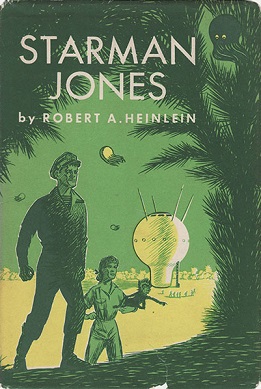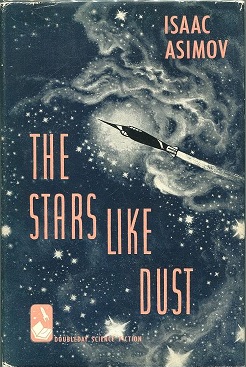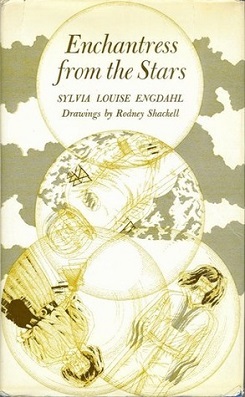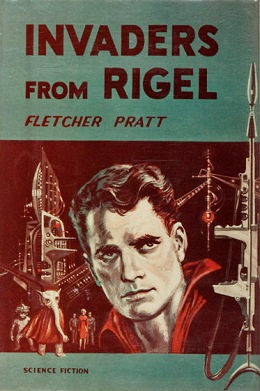
A Dyson sphere is a hypothetical megastructure that encompasses a star and captures a large percentage of its solar power output. The concept is a thought experiment that attempts to imagine how a spacefaring civilization would meet its energy requirements once those requirements exceed what can be generated from the home planet's resources alone. Because only a tiny fraction of a star's energy emissions reaches the surface of any orbiting planet, building structures encircling a star would enable a civilization to harvest far more energy.

Between Planets is a juvenile science fiction novel by American writer Robert A. Heinlein, originally serialized in Blue Book magazine in 1951 as "Planets in Combat". It was published in hardcover that year by Scribner's as part of the Heinlein juveniles.

Starman Jones, a 1953 science-fiction novel by Robert A. Heinlein, features a farm boy who wants to go to the stars. Charles Scribner's Sons published the book as part of the Heinlein juveniles series.

Time for the Stars is a juvenile science fiction novel by American writer Robert A. Heinlein, published by Scribner's in 1956 as one of the Heinlein juveniles. The basic plot line is derived from a 1911 thought experiment in special relativity, commonly called the twin paradox, proposed by French physicist Paul Langevin.

Citizen of the Galaxy is a science fiction novel by American writer Robert A. Heinlein, originally serialized in Astounding Science Fiction and published in hardcover in 1957 as one of the Heinlein juveniles by Scribner's. The story is heavily influenced by Rudyard Kipling's Kim.

Methuselah's Children is a science fiction novel by American writer Robert A. Heinlein. Originally serialized in Astounding Science Fiction in the July, August, and September 1941 issues, it was expanded into a full-length novel in 1958. The novel is part of Heinlein's Future History series of stories. It introduces the Howard families, a fictional group of people who achieved long lifespans through selective breeding.

The Stars, Like Dust is a 1951 science fiction mystery book by American writer Isaac Asimov.

The City and the Stars is a science fiction novel by British writer Arthur C. Clarke, published in 1956. This novel is a complete rewrite of his earlier Against the Fall of Night, Clarke's first novel, which had been published in Startling Stories magazine in 1948 after John W. Campbell, Jr., editor of Astounding Science-Fiction, had rejected it, according to Clarke.
The zoo hypothesis speculates on the assumed behavior and existence of technologically advanced extraterrestrial life and the reasons they refrain from contacting Earth. It is one of many theoretical explanations for the Fermi paradox. The hypothesis states that alien life intentionally avoids communication with Earth to allow for natural evolution and sociocultural development, and avoiding interplanetary contamination, similar to people observing animals at a zoo. The hypothesis seeks to explain the apparent absence of extraterrestrial life despite its generally accepted plausibility and hence the reasonable expectation of its existence. A variant on the zoo hypothesis suggested by the former MIT Haystack Observatory scientist John Allen Ball is the "laboratory" hypothesis, in which humanity is being subjected to experiments, with Earth serving as a giant laboratory.

The Man in the Maze is a science fiction novel by American writer Robert Silverberg, originally serialized in the magazine, Worlds of If April in May 1968, and published in bookstores the following year. It tells the tale of a man rendered incapable of interacting normally with other human beings by his uncontrollable psychic abilities. The novel is inspired by Sophocles' play Philoctetes, with the roles of Odysseus, Neoptolemus and Philoctetes played by Boardman, Rawlins, and Muller, respectively.

Non-Stop is a 1958 science fiction novel by British writer Brian Aldiss. It is about problems that the inhabitants of a huge generation space ship face after an alien amino acid that they picked up on another planet triggers a pandemic. Law and order began to collapse, and knowledge of the ship and of its purpose was eventually almost entirely lost throughout the vessel.
"The Crime and the Glory of Commander Suzdal" is a science fiction short story by Cordwainer Smith, set in Smith's "Instrumentality" universe. It was first published in Amazing Stories in May 1964, and is collected in The Rediscovery of Man compendium.

Across the Sea of Suns is a 1984 hard science fiction novel by American writer Gregory Benford. It is the second novel in his Galactic Center Saga, and continues to follow the scientist Nigel Walmsley, who encountered an extraterrestrial machine in the previous book, In the Ocean of Night, aboard an expeditionary spacecraft, searching for life. Eventually Nigel discovers evidence of the major conflict in the galaxy.

The Viagens Interplanetarias series is a sequence of science fiction stories by L. Sprague de Camp, begun in the late 1940s and written under the influence of contemporary space opera and sword and planet stories, particularly Edgar Rice Burroughs's Martian novels. Set in the future in the 21st and 22nd centuries, the series is named for the quasi-public Terran agency portrayed as monopolizing interstellar travel, the Brazilian-dominated Viagens Interplanetarias. It is also known as the Krishna series, as the majority of the stories belong to a sequence set on a fictional planet of that name. While de Camp started out as a science fiction writer and his early reputation was based on his short stories in the genre, the Viagens tales represent his only extended science fiction series.

The Venom Trees of Sunga is a science fiction novel by American writer L. Sprague de Camp, the twelfth book in his Viagens Interplanetarias series and the second in its subseries of stories set on the fictional planet Kukulkan. It was first published in paperback by Del Rey Books in November 1992. An E-book edition was published by Gollancz's SF Gateway imprint on September 29, 2011 as part of a general release of de Camp's works in electronic form.

Enchantress from the Stars is a young adult science fiction novel by Sylvia Engdahl published by Atheneum Books in 1970. It was her first or second book and is set in the Anthropology Service universe. Its sequel The Far Side of Evil (1971) features the same heroine, Elana, and the two are sometimes called the Elana series, although the sequel is quite different in tone.

"The Inspector's Teeth" is a science fiction short story by American writer L. Sprague de Camp, part of his Viagens Interplanetarias series. It is the first (chronologically) set on Earth, and a linchpin tale in the sequence, showing how the interstellar political system forming the background of the rest of the series was established. It was first published in the magazine Astounding in the issue for April, 1950. It first appeared in book form in the collection The Continent Makers and Other Tales of the Viagens, published in hardcover by Twayne Publishers in 1953, and in paperback by Signet Books in 1971. It also appeared in The Best of L. Sprague de Camp, and Anthropomorphic Aliens: An Interstellar Anthology. The story has been translated into Portuguese, Dutch, Italian and German.

"Memory", formerly A World Called Maanerek, is a science fiction novelette by American writer Poul Anderson, first published in the July 1957 issue of Galaxy Science Fiction magazine.

Invaders from Rigel is a science fiction novel by American writer Fletcher Pratt. It was first published in hardcover by Avalon Books in 1960. The first paperback edition was issued by Airmont Books in January 1964 and reprinted in December 1972, May 1973, January 1976, and at least one later occasion. The novel has also been translated into Italian. The book is an expansion of the author's novella "The Onslaught from Rigel," originally published in the magazine Wonder Stories Quarterly in the issue for Winter 1932. Pratt reused the name of the protagonist, Benjamin Franklin Ruby, in the form B. F. Ruby as an authorial pseudonym for later stories.

The Uplift Storm trilogy, also called The Uplift Trilogy is a series of novels set in David Brin's Uplift Universe. The entire trilogy is one long tale, with no gaps in the timeline between volumes. The three novels are:


















